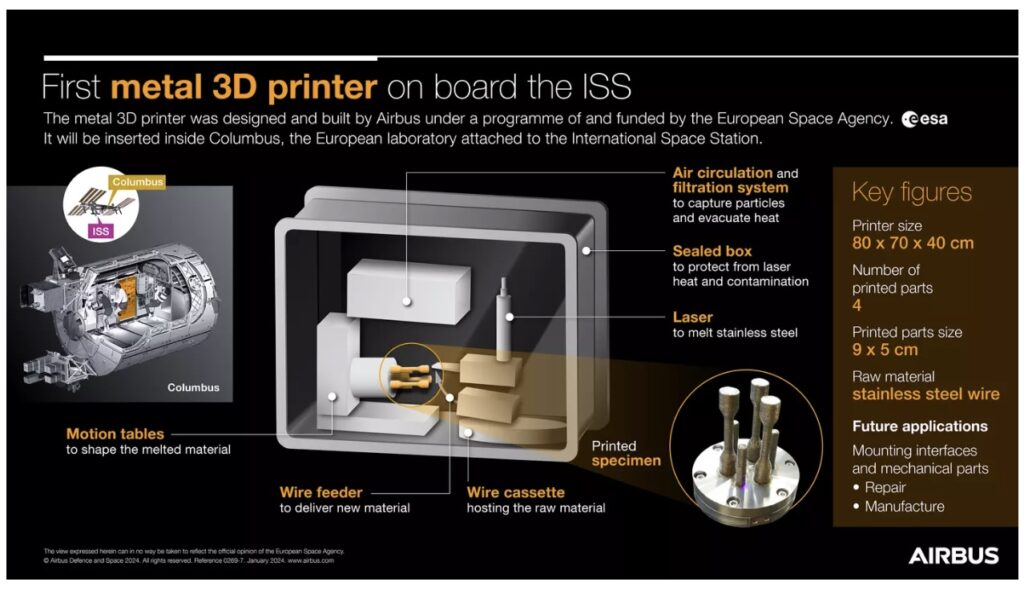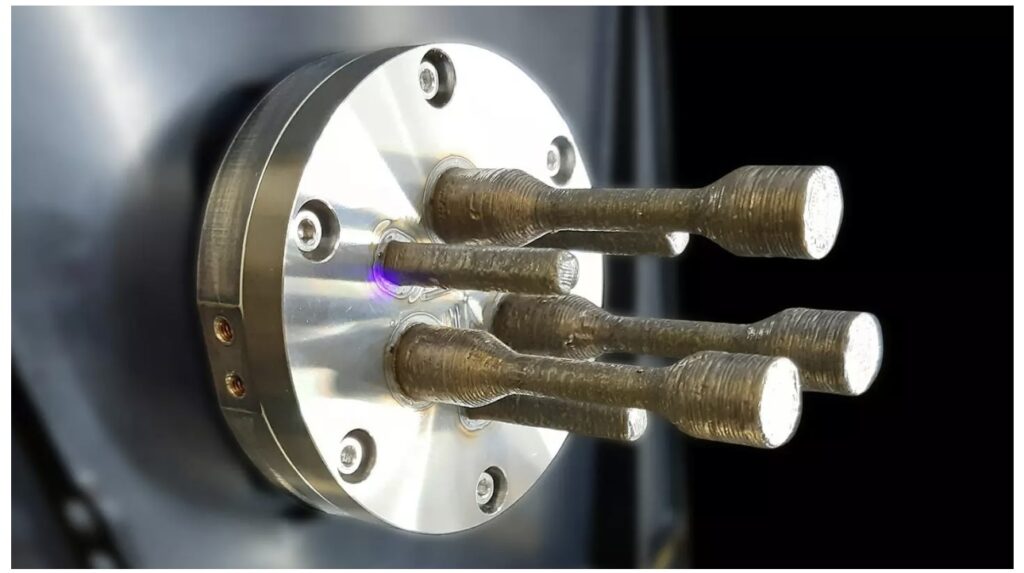French OEM AddUp, in collaboration with Airbus, has delivered the first metal 3D printer for space to the European Space Agency (ESA). This printer was launched on NASA’s Mission NG-20, bound for the International Space Station (ISS) aboard a SpaceX Falcon 9 rocket. Specially developed to function in microgravity, the printer will play a crucial role in the Huginn mission ESA astronaut and Falcon 9 pilot, Andreas Mogensen, which will see the crew 3D print in space on the Columbus European Science Module.
In development by AddUp and Airbus since 2016, with assistance from Cranfield University and aerospace contractor Highftech Engineering, the printer is a wire directed energy deposition (DED) system. Its design incorporates a cartridge for wire storage, while minimizing heat and particle emission and compensating for motion. Slated to begin operations as early as next month, this printer marks a significant advancement in metal 3D printing for space applications.
Prior explorations in space-oriented metal 3D printing have focused on technologies like electron beam melting for spare parts repair. This new printer represents an essential technological step forward, particularly as space missions become longer, more costly, and more critical. The ability to not only replace broken parts but also create improvised components for unforeseen emergencies or upgrades is a game-changer. Historically, several space disasters have been averted thanks to crew ingenuity and Duck Tape problem solving. The introduction of 3D printing in space opens up possibilities for more custom and effective solutions.
3D printing will be an essential tool if humans want to colonize other planets, mine in space, generate energy in orbit, and manage thousands of satellites. Its role in reducing the cargo necessary for missions, reutilizing potential waste, recycling onboard metals, and fabricating essential items on demand cannot be overstated. This technology significantly enhances mission efficiency by producing parts on-site and on-time, a much quicker solution than launching new supply missions, which could be vital for saving lives and extending the duration of missions.
In the context of a potential mission to Mars, the inevitability of unforeseen disasters makes the availability of 3D printed solutions critical. While space exploration has become more accessible, the impact of equipment failures, along with psychological and physical stresses, are immense. We must not forget 15 astronauts have lost their lives out of the 676 who have journeyed into space, with some having multiple, extended missions.
“The development of the Metal 3D printer relies on the unique multidisciplinary expertise of AddUp’s engineers and researchers. Our staff has expertise across a variety of additive manufacturing processes, machine design, programming and operation optimization. Our teams have supported the development of this first space metal 3D printer, which will soon be in orbit. The metal 3D printer has been designed and optimized to meet the conditions and environment of the International Space Station”“AddUp was chosen for this project based on a long history and partnership rooted in exploration and innovation,” said AddUp Technical Director Sébastien Devroe.
“We were confident that with the knowledge and experience the AddUp team has, combined with the technological expertise of Airbus, together we would be successful in delivering a high quality and efficient metal 3D printer to support the exploration of space,” stated Elodie Viau, Head of Engineering at Airbus Space Systems.
The upcoming tests, which involve comparing 3D printed parts created in space with those made on Earth, hold significant promise for the future of this technology. One particularly intriguing aspect is the potential for microgravity to enhance layer adhesion in 3D printed parts, a development that could mark a major advancement in the field. This is a crucial step for our technology.
Beyond metal additive manufacturing (AM), the further development of polymer 3D printing from recycled materials and the advancement of bioprinting are also necessary. The role of AM as an essential tool in space exploration is not only a testament to its credibility in critical applications but also positions the industry to capitalize on the expanding space market.
Additionally, this venture presents a unique opportunity for DED and wire laser deposition processes. Often perceived as less refined compared to powder bed fusion, these technologies stand to gain increased prestige, research funding, and attention. DED and other wire-based technologies are notable for their safety and versatility in using recycled materials of varying quality and characteristics. Furthermore, the adaptability of a laser DED system to function as a cutting and marking tool is an added advantage. DED’s capability in part rejuvenation, by adding new layers to worn parts, is also beneficial.
The heightened scrutiny and testing in the space context could attract new customers from the space, aerospace, and defense sectors, encouraging them to view DED technology in a new light. All things considered, this is a very good day for 3D printing.
Subscribe to Our Email Newsletter
Stay up-to-date on all the latest news from the 3D printing industry and receive information and offers from third party vendors.
You May Also Like
Further Understanding of 3D Printing Design at ADDITIV Design World
ADDITIV is back once again! This time, the virtual platform for additive manufacturing will be holding the first-ever edition of ADDITIV Design World on May 23rd from 9:00 AM –...
3D Printer Maker EVO-tech Reborn as NEVO3D — Once More With Feeling
EVO-tech was a 3D printing service and original equipment manufacturer established in 2013 and based in Schörfling am Attersee, Austria. The company produced high-quality material extrusion systems featuring linear bearings,...
3D Systems Brings 3D Printed PEEK Cranial Implant to the U.S. with FDA Clearance
For more than 10 years, 3D Systems (NYSE:DDD) has worked hand-in-hand with surgeons to plan over 150,000 patient-specific cases, and develop more than two million instruments and implants from its...
CDFAM Returns to Berlin for Second Annual Symposium
The second CDFAM Computational Design Symposium is scheduled for May 7-8, 2024, in Berlin, and will convene leading experts in computational design across all scales. Building upon the first event...


































